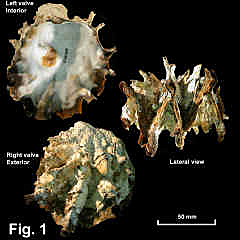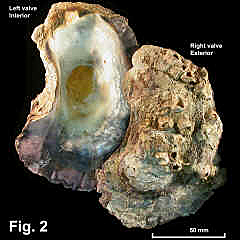|
|
GRYPHAEIDAE |
|
|
|
Hyotissa hyotis (Linnaeus, 1758) Description: Shell varying from moderate in weight as juvenile to massively heavy when adult. Shape variable from roughly circular to elongate; left valve adhering to substrate and shaped by it. Hinge broad. Interior white with single large muscle scar with elevated edge ventrally; margin wide, purple-black; small ridges across margin near hinge. Exterior of small specimens with sharp V shaped ribs bearing tubular spines (Fig. 1); large specimens with severely eroded, featureless surface (Fig. 2). Shell colour brown or green in small specimens, indeterminate in large shells. Size: Up to 300 mm in height. Distribution: Indo-West Pacific. In Australia, from south-western WA, around northern Australia, to Solitary Islands, NSW. Specimens dredged from Sydney Harbour are fossils representing a vagrant population that lived there during a time of warmer sea temperatures. Habitat: Lives attached to corals or rocks in low intertidal and shallow subtidal. Large specimens can fall off their substrate and live unattached on the bottom. Comparison: Small specimens can look like Dendostrea folium but that species lacks spines. Remarks: The difference between small specimens, up to a 100 mm or so, and large specimens is remarkable. The smaller shells show the classic saw-tooth character which disappears as the shells grow, leaving large shells as featureless ‘lumps’. Fig. 1: Big Upolo Cay, N.E. of Cairns, Qld (C.110140) Fig. 2: North Solitary Island, NSW. 10 m depth (C.099854) |
|

